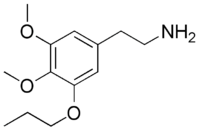Metaproscaline
 | |
| Names | |
|---|---|
| IUPAC name
2-(3,4-dimethoxy-5-propoxyphenyl)ethanamine | |
| Identifiers | |
| 90132-33-5 | |
| 3D model (Jmol) | Interactive image |
| ChEMBL | ChEMBL161588 |
| ChemSpider | 21106345 |
| |
| |
| Properties | |
| C13H21NO3 | |
| Molar mass | 239.311 g/mol |
| Except where otherwise noted, data are given for materials in their standard state (at 25 °C [77 °F], 100 kPa). | |
| | |
| Infobox references | |
Metaproscaline, or 3,4-dimethoxy-5-propoxyphenethylamine, is a lesser-known psychedelic drug. It is an analog of proscaline. Metaproscaline was first synthesized by Alexander Shulgin. In his book PiHKAL (Phenethylamines i Have Known And Loved), the dosage and the duration are unknown. Metaproscaline produces few to no effects. Very little data exists about the pharmacological properties, metabolism, and toxicity of metaproscaline.
See also
External links
This article is issued from Wikipedia - version of the 7/7/2015. The text is available under the Creative Commons Attribution/Share Alike but additional terms may apply for the media files.